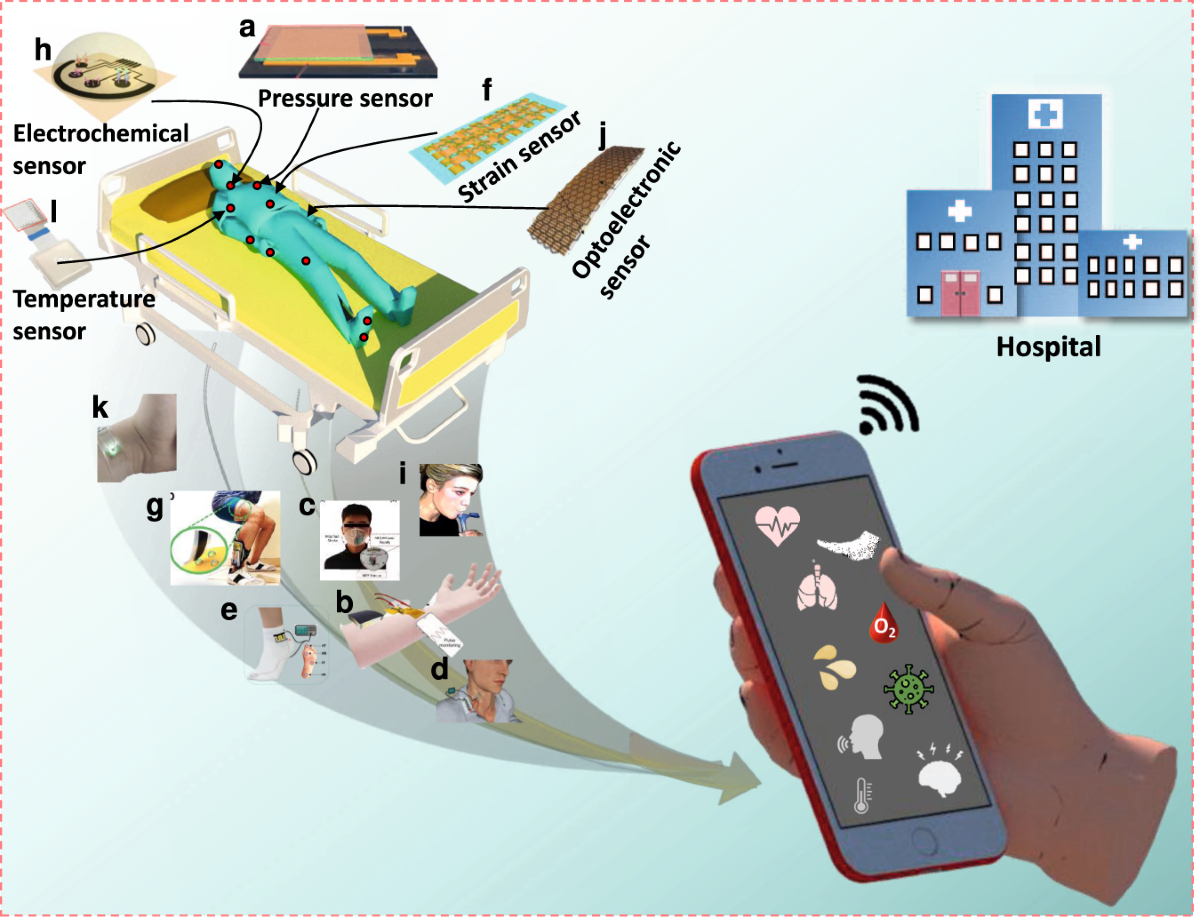Wearable Biosensors That Monitor Mental & Emotional Biomarkers- Ten years ago, most wearables could only count steps and measure heart rate.
Today, they can sense your stress, track your sleep quality, and even hint when you’re about to feel anxious.
Welcome to the age of wearable biosensors — intelligent devices that don’t just monitor your physical health, but also tap into your mental and emotional state.
This is where neuroscience meets wearable tech, and it’s reshaping how we understand — and manage — our minds.
What Are Wearable Biosensors?
Wearable biosensors are smart devices equipped with miniature sensors that continuously track your body’s biological signals (called biomarkers).
These biomarkers can include:
-
Heart rate and variability
-
Skin temperature
-
Sweat composition
-
Electrical activity in muscles or the brain
-
Blood oxygen and glucose levels
The data collected helps reveal what’s happening inside your body — in real time.
Traditionally, biosensors focused on physical health (like fitness or disease detection). But the latest generation takes it a step further: they can sense your emotions.
How Can a Device “Read” Emotions?
Here’s the fascinating part — emotions leave biological footprints.
When you’re stressed, anxious, happy, or relaxed, your body subtly changes:
-
Your heart rate increases or steadies
-
Your skin conductance shifts (you sweat more when nervous)
-
Your brain waves alter patterns
-
Even your pupil size and body temperature respond
Modern biosensors detect these physiological cues and, with the help of AI algorithms, interpret them into emotional patterns.
It’s not mind reading — it’s biofeedback decoding.
Why Are Mental & Emotional Biomarkers Important?
Mental health is no longer invisible. Biomarkers — objective, measurable biological signals — are giving scientists and doctors a clearer window into conditions once diagnosed only through observation or self-reporting.
For example:
-
Changes in heart rate variability (HRV) are linked to stress and resilience.
-
Altered cortisol levels can indicate chronic anxiety or burnout.
-
EEG (electroencephalography) signals reveal neural activity connected to mood disorders.
By continuously tracking these indicators, wearable biosensors can:
-
Detect early signs of stress, anxiety, or depression
-
Help users regulate emotions through feedback
-
Support therapists and clinicians in personalized care
In short, mental health monitoring is shifting from reactive to proactive.
How Do Wearable Biosensors Actually Work?
Most wearable biosensors combine three key technologies:
-
Physiological Sensors – These measure signals like heart rate, skin temperature, and sweat.
-
Example: Photoplethysmography (PPG) sensors in smartwatches track pulse changes.
-
-
Data Processing Units – Tiny onboard processors analyze raw data and look for patterns.
-
AI & Machine Learning – The device learns your individual “baseline” and recognizes deviations that might suggest stress, fatigue, or anxiety.
Some even sync with mobile apps that coach you in real time — guiding you through breathing exercises, mindfulness reminders, or suggesting rest breaks when stress spikes.
What Are Some Emerging Devices in This Space?
Several cutting-edge wearables are redefining mental wellness tracking:
-
Empatica E4: Used in research and clinical settings, it measures electrodermal activity, skin temperature, and movement to detect emotional arousal.
-
Muse Headband: Tracks brain waves (EEG) and provides real-time feedback to help users meditate and calm their minds.
-
Apollo Neuro: Uses gentle vibrations to influence the nervous system and improve stress resilience.
-
Oura Ring: Measures HRV, temperature, and sleep cycles, giving insights into mood and recovery.
-
Fitbit Sense & Apple Watch Series 9: Integrate stress detection, mindfulness tracking, and emotion-based notifications.
While each works differently, their goal is shared: helping people understand and regulate their emotional health.
How Wearable Biosensors Could Revolutionize Mental Health Care
The potential impact is enormous.
1. Early Detection of Mental Strain
Instead of waiting for burnout or depression to hit, biosensors can flag early biological signs of chronic stress — allowing timely intervention.
2. Personalized Mental Health Plans
Data-driven insights could help therapists and doctors design personalized coping strategies. Imagine your device telling your counselor, “This week’s stress peaks happened every Monday morning.”
3. Biofeedback-Based Therapy
Devices that monitor and respond to your biometrics enable biofeedback training — where users learn to consciously control stress responses.
4. Workplace Wellness
Employers are exploring biosensors to track collective stress levels (anonymously) and improve work-life balance.
5. Continuous Monitoring for High-Risk Individuals
For patients with PTSD, anxiety, or bipolar disorder, biosensors could alert caregivers or apps when emotional dysregulation begins — before a full episode occurs.
Why It’s a Game-Changer for Personalized Treatment
Mental health is deeply individual — what triggers stress in one person might energize another.
Wearable biosensors allow medicine to see those personal differences clearly.
By continuously collecting emotional biomarker data:
-
Doctors can see how treatments affect real-world moods.
-
Medications or therapies can be adjusted based on biofeedback.
-
AI models can predict what situations cause emotional distress and recommend preventive strategies.
This level of precision transforms mental health from guesswork into data-driven care — the foundation of true personalized medicine.
What Challenges Still Exist?
While the future is promising, several hurdles remain:
-
🔋 Battery Life: Continuous monitoring drains energy fast.
-
🔒 Privacy: Emotional data is deeply personal. How it’s stored and shared matters.
-
🧠 Accuracy: Emotions are complex; no device can perfectly interpret them yet.
-
💰 Cost: Advanced biosensors remain expensive, limiting access.
-
⚖️ Ethical Concerns: Should companies or apps know when you’re stressed or sad?
To make this technology widely acceptable, developers and health authorities must create strong ethical and privacy frameworks.
Frequently Asked Questions (FAQs)
1. Can a wearable really detect emotions accurately?
Not perfectly — but they’re getting close. By combining multiple signals (like heart rate, sweat, and temperature), biosensors can predict stress or relaxation states with high reliability.
2. Are these devices meant to replace therapists?
No. They’re support tools, not substitutes. Wearables provide data; human professionals provide context, empathy, and treatment.
3. Can biosensors help reduce anxiety?
Yes. Many users report better awareness of their emotional triggers and improved coping after using devices that guide breathing or mindfulness.
4. Are mental biomarkers the same for everyone?
Not exactly. Each person has a unique physiological “signature.” That’s why AI models personalize readings over time.
5. What’s next for this technology?
Future biosensors might measure brain chemistry, integrate AI-driven emotional assistants, or even interact with virtual therapy environments — blending mental health support seamlessly into daily life.
The Future: Listening to the Language of the Body
Our bodies speak constantly — through heartbeats, sweat, and micro changes in temperature.
For centuries, we ignored these signals.
Now, wearable biosensors are translating them into insights that can improve mental balance, emotional awareness, and overall well-being.
The technology isn’t perfect yet, but its promise is enormous: a world where your smartwatch doesn’t just count your steps — it helps you take care of your mind.




